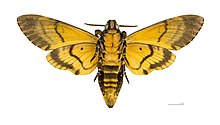Acherontia atropos
| African death's head hawkmoth | |
|---|---|
 |
|
| Acherontia atropos ♀ MHNT | |
 |
|
| Acherontia atropos ♀ △ MHNT | |
| Scientific classification | |
| Kingdom: | Animalia |
| Phylum: | Arthropoda |
| Class: | Insecta |
| Order: | Lepidoptera |
| Family: | Sphingidae |
| Genus: | Acherontia |
| Species: | A. atropos |
| Binomial name | |
|
Acherontia atropos (Linnaeus, 1758) |
|
 |
|
| Distribution map (red: all year distribution; orange: summer distribution possible) | |
| Synonyms | |
|
|
Acherontia atropos (Greater death's head hawkmoth) is the most widely known of the three species of death's-head hawkmoth. Acherontia species are notorious for a vaguely skull-shaped pattern on the thorax.
Acherontia atropos is a large hawk moth with a wingspan of 90–130 mm (about 3.5 to 5 inches), being the largest moth in some of the regions in which it occurs. The adult has the typical streamlined wings and body of the hawk moth family, Sphingidae. The upper wings are brown with slight yellow wavy lines; the lower wings are yellow with some wide brown waves. It rests during the day on trees or in the litter, holding the wings like a tent over the body.
The moth also has numerous other unusual features. It has the ability to emit a loud squeak if irritated. The sound is produced by expelling air from its proboscis. It often accompanies this sound with flashing its brightly marked abdomen in a further attempt to deter its predators. It is commonly observed raiding beehives for honey at night. Unlike the other species of Acherontia, it only attacks colonies of the well-known Western honey bee, Apis mellifera. It is attacked by guard bees at the entrance, but the thick cuticle and resistance to venom allow it to enter the hive. It is able to move about in hives unmolested because it mimics the scent of the bees.
The British entomological journal Atropos takes its name from this species.
The species name Atropos is related to death, derived from atropos that may not be turned, from a-1 + -tropos (Greek: τρόπος) from trepein to turn. Atropos was one of the three Moirai, goddesses of and destiny. In addition the genus name Acherontia is derived from Acheron, a river in Greece, which in Greek mythology was known as the river of pain, and was one of the five rivers of the Greek underworld.
...
Wikipedia
